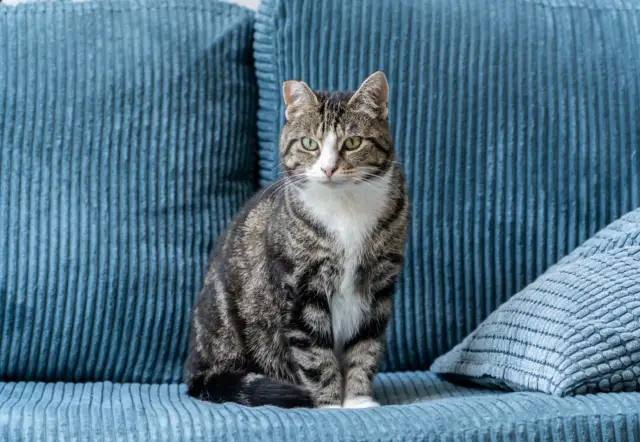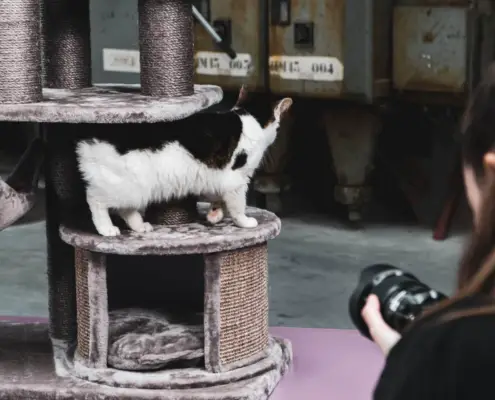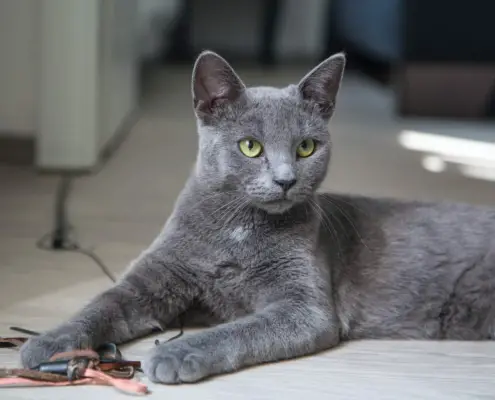
Cats are known for their natural instinct to scratch, and unfortunately, our beloved furniture often falls victim to their sharp claws. But have you ever wondered why cats scratch furniture in the first place? Understanding the reasons behind this behavior is the first step towards finding a solution.
One of the main reasons why cats scratch furniture is to mark their territory. Cats have scent glands in their paws, and when they scratch, they leave behind both visual and olfactory marks. By scratching furniture, they are essentially saying, “This is my territory.” Additionally, scratching helps cats stretch their muscles and remove the outer layer of their claws, keeping them sharp and healthy.
Understanding the instincts behind scratching
To truly comprehend why cats scratch furniture, we must delve deeper into their instincts. Cats are natural hunters, and scratching is an innate behavior that helps them keep their claws in top shape for hunting prey. In the wild, cats would scratch trees to sharpen their claws and mark their territory. While our domesticated feline friends may not have to hunt for their meals, their instincts remain intact.
Scratching also serves as a form of exercise for cats. It allows them to stretch their muscles and maintain their flexibility. Additionally, scratching helps cats relieve stress and frustration. Just like humans need an outlet for their emotions, cats need a way to release their pent-up energy and tension.
The benefits of scratching for cats
While it may be frustrating to find your furniture torn apart, it’s important to realize that scratching is a natural and beneficial behavior for cats. By scratching, cats are not only marking their territory but also enjoying several physical and mental benefits. Regular scratching helps cats maintain healthy and strong claws, which are essential for climbing and self-defense.
Moreover, scratching serves as a form of communication among cats. It is their way of leaving messages for other felines in the area. By scratching, cats can convey information about their presence, status, and readiness to mate. It’s a vital part of their social interaction, even if it may result in a few scratched couches along the way.
Common misconceptions about cat scratching
There are several misconceptions surrounding cat scratching that can lead to misunderstandings and frustration. One common misconception is that cats scratch furniture out of spite or to seek revenge. This couldn’t be further from the truth. Cats do not possess the cognitive ability to engage in revenge-seeking behavior. Scratching is simply a natural instinct for them, and they do not associate it with any negative intentions.
Another misconception is that declawing is a viable solution to prevent cat scratching. Declawing is an invasive and painful procedure that involves removing a cat’s claws. Not only is it considered inhumane by many, but it can also lead to physical and behavioral problems. Cats rely on their claws for various activities, such as climbing, grooming, and self-defense. Removing their claws can cause long-term physical and emotional distress.
Signs that your cat may be scratching furniture
If you suspect that your cat is scratching your furniture, there are several signs to look out for. Visible scratch marks on your furniture are an obvious indication that your cat has been busy. Additionally, you may notice shredded upholstery, torn fabric, or even wood chips around the scratching areas.
Another sign to watch for is your cat’s body language while scratching. If your cat assumes a stretched-out posture with their back arched and their claws fully extended, it’s a clear indication that they are engaged in scratching behavior. Some cats may also vocalize or purr while scratching, further confirming their enjoyment of the activity.
How to prevent cat scratching on furniture
Preventing cat scratching on furniture requires a combination of understanding your cat’s needs and providing them with appropriate alternatives. Here are some effective strategies to keep your furniture safe and your cat satisfied:
Providing alternative scratching options for your cat
One of the best ways to prevent cat scratching on furniture is to provide your furry friend with suitable alternatives. Invest in a sturdy scratching post or cat tree that is tall enough for your cat to fully stretch their body. Choose a scratching post made of sisal or corrugated cardboard, as these materials mimic the texture of tree bark and are more appealing to cats.
Place the scratching post near the furniture that your cat is prone to scratching. Encourage your cat to use the scratching post by rubbing it with catnip or using a wand toy to entice them to scratch. Be patient and reward your cat with treats or praise when they use the scratching post. Consistency is key in training your cat to redirect their scratching behavior.
Using deterrents and training techniques
If your cat continues to scratch furniture despite having suitable alternatives, you can try using deterrents to discourage them. Double-sided tape, aluminum foil, or plastic sheeting can be placed on the furniture to create an unpleasant texture that cats dislike. You can also use pet-safe sprays or scents that are unappealing to cats, such as citrus or lavender.
Positive reinforcement training can also be effective in redirecting your cat’s scratching behavior. Whenever you catch your cat scratching the furniture, calmly redirect them to the scratching post. Reward them with treats or praise when they use the post instead. Consistency and patience are crucial in reinforcing the desired behavior.
Seeking professional help for excessive scratching
If your cat’s scratching behavior becomes excessive or destructive, it may be necessary to seek professional help. A veterinarian or a certified animal behaviorist can assess your cat’s individual needs and provide tailored advice and solutions. They can help identify any underlying medical conditions or behavioral issues that may be contributing to the excessive scratching.
It’s important to address excessive scratching promptly, as it can lead to injuries, infections, or damage to your furniture. With the guidance of a professional, you can implement appropriate strategies to manage the behavior and improve your cat’s overall well-being.
Conclusion
Understanding why cats scratch furniture is key to finding a solution that benefits both you and your feline companion. By recognizing the natural instincts behind scratching and providing suitable alternatives, you can protect your beloved furniture while ensuring your cat’s physical and mental well-being. Remember, scratching is a normal behavior for cats, and with patience, consistency, and the right approach, you can guide your cat towards more appropriate scratching habits. So, invest in a quality scratching post, use deterrents when necessary, and seek professional help if needed. With proper care and attention, you can create a harmonious environment where both you and your cat can coexist happily.
If you enjoyed my article, I would appreciate you sharing it with your network.

Sima Ndlebe
Sima writes for CatBuzz. He is interested in Cats, Health and Fitness, and Entrepreneurship.
Published: 16 November 2023




